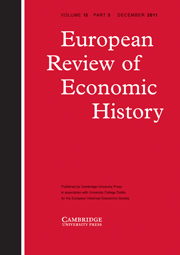Crossref Citations
This article has been cited by the following publications. This list is generated based on data provided by
Crossref.
Calvo, Ángel Calvo
2001.
Los inicios de las telecomunicaciones en España: el telégrafo.
Revista de Historia Económica / Journal of Iberian and Latin American Economic History,
Vol. 19,
Issue. 3,
p.
613.
Kallioinen, Mika
2004.
Information, communication technology, and business in the nineteenth century: The case of a Finnish merchant house.
Scandinavian Economic History Review,
Vol. 52,
Issue. 1,
p.
19.
Jacks, David S.
2005.
Intra- and international commodity market integration in the Atlantic economy, 1800–1913.
Explorations in Economic History,
Vol. 42,
Issue. 3,
p.
381.
Bogart, Dan
2005.
Turnpike trusts and the transportation revolution in 18th century England.
Explorations in Economic History,
Vol. 42,
Issue. 4,
p.
479.
Jacks, David S.
2006.
What drove 19th century commodity market integration?.
Explorations in Economic History,
Vol. 43,
Issue. 3,
p.
383.
Goetzmann, William N.
and
Ukhov, Andrey D.
2006.
British Investment Overseas 1870–1913: A Modern Portfolio Theory Approach*.
Review of Finance,
Vol. 10,
Issue. 2,
p.
261.
Wenzlhuemer, Roland
2007.
The Development of Telegraphy, 1870–1900: A European Perspective on a World History Challenge.
History Compass,
Vol. 5,
Issue. 5,
p.
1720.
Wenzlhuemer, Roland
2007.
The dematerialization of telecommunication: communication centres and peripheries in Europe and the world, 1850–1920.
Journal of Global History,
Vol. 2,
Issue. 3,
p.
345.
Federico, Giovanni
2007.
Market integration and market efficiency: The case of 19th century Italy.
Explorations in Economic History,
Vol. 44,
Issue. 2,
p.
293.
Esteves, Rui
Reis, Jaime
and
Ferramosca, Fabiano
2007.
Market Integration in the Golden Periphery: The Lisbon/ London Exchange, 1854-1891.
SSRN Electronic Journal,
Lampe, Markus
2009.
Effects of Bilateralism and the MFN Clause on International Trade: Evidence for the Cobden-Chevalier Network, 1860-1875.
The Journal of Economic History,
Vol. 69,
Issue. 4,
p.
1012.
Esteves, Rui Pedro
Reis, Jaime
and
Ferramosca, Fabiano
2009.
Market Integration in the Golden Periphery. The Lisbon/London Exchange, 1854–1891.
Explorations in Economic History,
Vol. 46,
Issue. 3,
p.
324.
Malecki, Edward J.
and
Wei, Hu
2009.
A Wired World: The Evolving Geography of Submarine Cables and the Shift to Asia.
Annals of the Association of American Geographers,
Vol. 99,
Issue. 2,
p.
360.
Tamaki, Toshiaki
2010.
The Baltic as a shipping and information area: the role of Amsterdam in Baltic integration in early modern Europe.
Asia Europe Journal,
Vol. 8,
Issue. 3,
p.
347.
Federico, G.
2011.
When did European markets integrate?.
European Review of Economic History,
Vol. 15,
Issue. 1,
p.
93.
Uebele, Martin
2011.
National and international market integration in the 19th century: Evidence from comovement.
Explorations in Economic History,
Vol. 48,
Issue. 2,
p.
226.
Jørgensen, Claus Møller
2012.
Transurban interconnectivities: an essay on the interpretation of the revolutions of 1848.
European Review of History: Revue europeenne d'histoire,
Vol. 19,
Issue. 2,
p.
201.
Boyce, Gordon
2012.
The World's Key Industry.
p.
106.
DOBADO-GONZÁLEZ, RAFAEL
GARCÍA-HIERNAUX, ALFREDO
and
GUERRERO, DAVID E.
2012.
The Integration of Grain Markets in the Eighteenth Century: Early Rise of Globalization in the West.
The Journal of Economic History,
Vol. 72,
Issue. 3,
p.
671.
Uebele, M.
2013.
What Drives Commodity Market Integration? Evidence from the 1800s.
CESifo Economic Studies,
Vol. 59,
Issue. 2,
p.
412.


